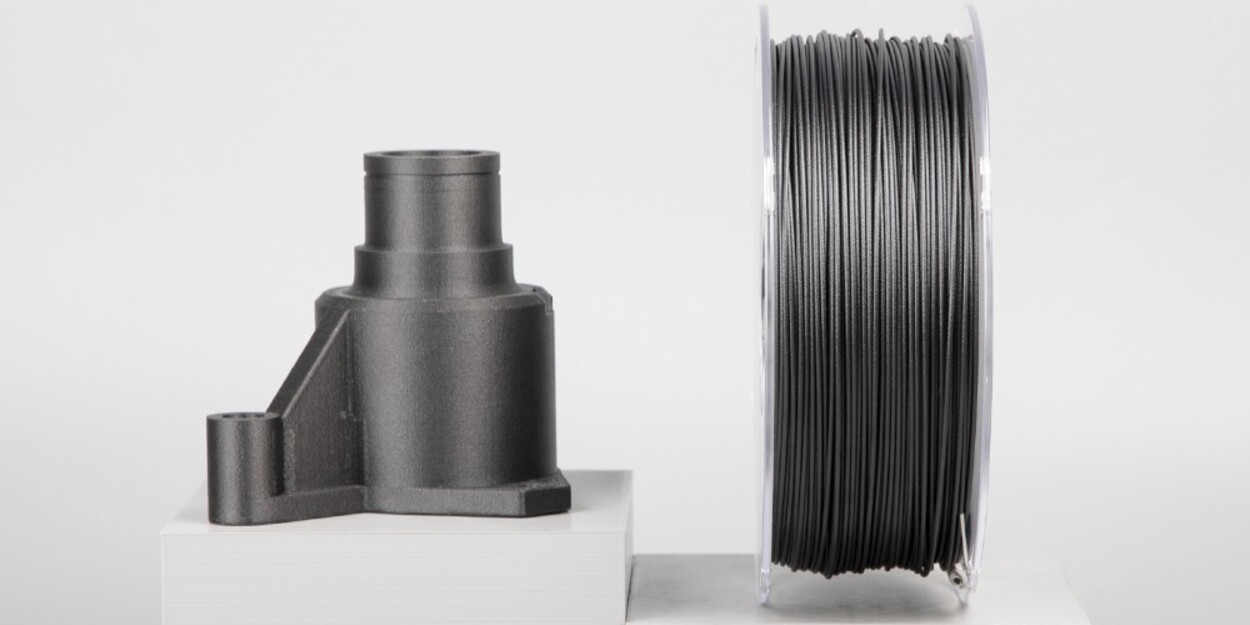Banner Image Courtesy of Kexcelled
What Is Carbon Filament?
Carbon fiber filament is a composite 3D printing material that combines a thermoplastic base (commonly PLA, PETG, Nylon, PEEK, etc.) with finely chopped carbon fibers.
The infusion of carbon fibers imparts exceptional stiffness, dimensional stability, and a matte, industrial aesthetic to printed parts. Unlike continuous carbon fiber reinforcement, which requires specialized printers and layup techniques, chopped–fiber filament is compatible with most desktop FDM/FFF machines equipped with a hardened steel or ruby-tipped nozzle to resist abrasion.
Key Material Properties
Increased Rigidity and Stiffness
Carbon fibers, even in chopped form, significantly boost the modulus of the composite. Printed parts resist bending and deflection better than unfilled thermoplastic equivalents.
Dimensional Stability
The carbon fibers reduce filament shrinkage and warping during cooling, resulting in more accurate, dependable prints—especially in materials like Nylon, which normally suffer from distortion.
Lightweight Strength
Despite added stiffness, carbon fiber composites remain relatively light, which makes them ideal where a high strength-to-weight ratio is critical (e.g., drone components, robotics frames).
Matte Finish & Aesthetics
The chopped fibers create a subtly textured, industrial–looking matte surface that hides layer lines and gives parts a professional appearance without post-processing.
Thermal Resistance
Depending on the thermoplastic base, these filaments can withstand elevated temperatures better than PLA. Carbon fiber Nylon, for example, tolerates temperatures above 100 °C, making it suitable for under-hood automotive parts.
Pros and Cons of 3D Printing Carbon Fiber Filament
|
Pros |
Cons |
|
Exceptional stiffness and rigidity |
Abrasive on standard nozzles—requires hardened steel or ruby nozzle |
|
Improved dimensional accuracy and reduced warping |
Higher cost than standard PLA or PETG |
|
Lightweight strength ideal for structural applications |
Lower impact resistance and toughness compared to unfilled counterparts (can be brittle) |
|
Matte, industrial aesthetic hides layer lines |
Limited color options (typically black or dark gray) |
|
Good thermal resistance (depending on base polymer) |
Can clog hotends if moisture-laden—requires dry storage |
Types of Carbon Fiber Filaments
1. PLA-Based Carbon Fiber
Ease of Use: Very beginner-friendly, minimal warping, sticks well to most build plates.
Applications: Concept prototypes, decorative prototypes, jigs and fixtures.
2. PETG-Based Carbon Fiber
Strength & Durability: Improved toughness over PLA, moderate flexibility, good layer adhesion.
Applications: Functional prototypes, mechanical parts exposed to humidity.
3. Nylon-Based Carbon Fiber
High Performance: Superior strength, abrasion resistance, and heat tolerance, but prone to moisture absorption.
Applications: End-use mechanical parts, gears, bearings, drone frames.
4. ABS-Based Carbon Fiber
Balance of Properties: Good toughness, higher heat resistance than PLA, though more warping than PETG.
Applications: Automotive housings, enclosures, tool handles.
5. Specialty Hybrids
PEEK/PEI-Based Carbon Fiber: Ultra-high temperature resistance for aerospace and medical components; requires industrial-grade printers.
Bio-Derived Polymers: Emerging options for sustainability combined with carbon fiber reinforcement.
Top Applications for Carbon Fiber 3D Prints
Drones & UAV Components
Frames, arms, and mounts benefit from high stiffness and low weight, extending flight time and payload capacity.
Automotive & Motorsport
Custom brackets, air ducts, and interiors where weight savings and thermal stability are crucial.
Industrial Jigs & Fixtures
Tooling that requires dimensional accuracy and rigidity under repetitive loads.
Robotics
Structural parts, end-effectors, and protective housings require stiffness without bulk.
Consumer Electronics Housings
Phone cases, camera mounts, and wearable device enclosures combine a sleek finish with protection.
Sports Equipment Prototypes
Bicycle accessories, helmet components, and training aids that demand strength and lightness.
FAQs
Q: Is carbon fiber filament strong?
A: Yes. While chopped-fiber composites are not as strong as continuous-fiber parts, they offer a substantial increase in stiffness and dimensional stability over unfilled filaments.
Q: Do I need a special nozzle for carbon fiber filament?
A: Absolutely. The abrasive nature of carbon fibers will quickly wear a standard brass nozzle. Hardened steel or ruby-tipped nozzles are highly recommended.
Q: Can I print carbon fiber filament at high speeds?
A: It’s best to print at moderate speeds (30 – 50 mm/s). Higher speeds can exacerbate vibrations and reduce layer adhesion due to the stiffer composite.
Q: How do I store carbon fiber filament?
A: Store in a cool, dry place with desiccant packs inside sealed containers. Nylon CF filaments are especially hygroscopic.
Q: What post-processing works best?
Light sanding and clear-coat spraying can enhance the matte finish. Avoid aggressive machining or polishing, as the fibers can protrude.
Q: Can I use carbon fiber filament for outdoor parts?
A: Depending on the polymer base. PETG and Nylon variants resist UV and humidity better than PLA, making them more suitable for outdoor use.














